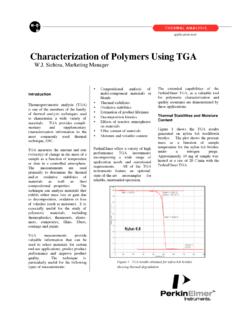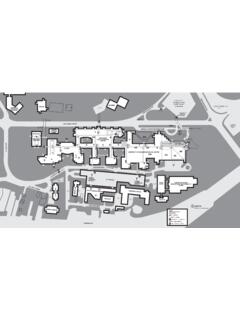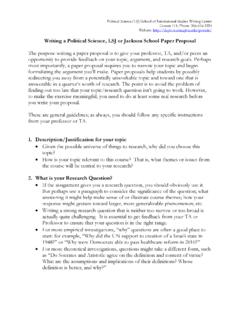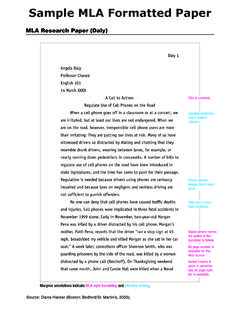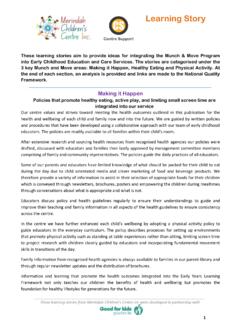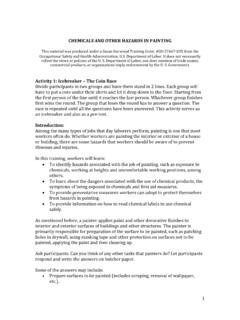Transcription of SAMPLE WORK-UP
1 SAMPLE WORK-UPID: Patient is 21 yo G2P1001 At 32 2/7 GA determined by serial U/S Admitted forvaginal : The patient first noticed vaginal bleeding this morning when she work up at 6:25 amto use the restroom. She noticed bleeding in her clothing and blood clots in the toiletbowl. She was transported by ambulance to the hospital from the prison she has been for4 months. She reports bleeding 1 cup (~250cc) total this morning. In addition, she has apositive h/o placenta previa with her current pregnancy determined by U/S. She deniesany similar episodes in the past with either pregnancy, as well as having pain, cramps,nausea, fever, chills or recent Care: Dr. _____ at Farm Worker s ClinicPregnancy complicated by:1) Partial placenta previaPNL:- Blood type: O+- Rubella Ab titer: Immune- VDRL: NR- Hep B: NR- Cervical gonorrhea & Chlamydia culture:- Pap smear: normal- PPD: not done- Sickle prep: not done- HIV test: NR- Glucose test: Denies having it done- Group B strep: not done- Herpes: Denies- Seizures: Denies- Hep C: NRPMH:Gyn PMH:- Menarches: 15 yoa- Menses: Regular 28 day cycles with 4 day duration menses; heavy flow first twodays and becomes gradually lighter toward end of menses- Contraception hx: Denies use of barrier or hormonal PMH:- 2002: C-section 2ary to non-reassuring fetal heart tracings, boy, wgt: 7 lbs.
2 Givenfor :- c-section: 2002, no complication- Indirect hernia: At 5 yoaCurrent medications: Prenatal multivitaminsAllergies: PenicillinHabits/risk factors:- EtOH: Denies use- Tobacco use: Denies use- Recreational drugs/others: Marijuana, every other day; has not smoked sinceincarceration 4 months : The patient grew up in California with her mother and she has no siblings. She hasan 11th grade education. She came to visit a friend in Yakima, WA, one year ago and hasstayed in Yakima ever since. She denies having a job and states to meet her financialneeds by having friends and her mother help her with : UnremarkablePE:- VS: BP: 116/73 (sitting), P: 89, RR: 18, T: Gen: Well-nourished, slender body habitus, A & O, in NAD- Skin: Pink, cool and dry- Pulmonary: LCAB- Back: No CVA or spinal tenderness to percussion- CV: RRR, no murmurs Abd: Borborgymi present. Distended, no tenderness to palpation- Fundus: 32 cm, firm- Extremities: No edema- NST: baseline FHR of 137, reactive with accelerations and frequent variability- U/S: Reveals placenta with partial coverage of cervical internal :1) Hemodynamically stable 21 yo G2P1001 with vaginal bleeding and U/Sconsistent with placenta Diagnosis:1) Obstetric causes:a.
3 Placental: Placental previa, placental abruption, circumvallata placenta,placenta accreta, placenta increta, placenta percretab. Maternal: Uterine rupture, clotting disordersc. Fetal: Fetal vessel rupture2) Non-obstetric causes:a. Cervical: Severe cervicitis, polyps, benign/malignant neoplasmsb. Vaginal: Lacerations, varices, benign/malignant neoplasmsc. other : Hemorrhoids, bleeding disorder, abd/pelvic traumaDiscussion:There are multiple causes of vaginal bleeding on the third trimester of causes of vaginal bleeding include placental abruption, which is seen in 30% of3rd trimester hemorrhages. IN placental abruption, there is a premature separation ofnormally implanted placenta from uterine wall resulting in hemorrhage between uterinewall and placenta. It can present with painful bleeding, but no always, in conjunctionwith abdominal paint, uterine tenderness and uterine contractions. Risk factors forplacenta abrupta are hypertension, history of abruption, trauma, AMA, cigarette/cocaineuse, rapid decompression of overextended uterus.
4 When placental abruption is consideredas a possible cause of vaginal bleeding, it is necessary to obtain a CDC, coagulationpanel, fibrinogen levels, FDP, Apt test, ultrasound, and sterile speculum exam. Inaddition, blood type and cross match should be ready in case of previa occurs in 20% of 3rd trimester hemorrhage and should also be part of thedifferential diagnosis. Placenta previa occurs when there is abnormal implantation ofplacenta over internal cervical os, which an be complete, partial or marginal. The classicpresentation of placenta previa involves painless vaginal bleeding (in 70% of cases), andit is more common in the third trimester. Risk factors for placenta previa include priorplacenta previa, uterine, scars, multiple gestations, multiparity, prior cesarean, cigarettesmoking, and weakly with AMA. The average gestational age at the time of first bleedingepisode is 29-30 wks. Although bleeding may be substantial, is usually resolvesspontaneously.
5 The bleeding is a result of separation of part of the placenta from thelower uterine segment and cervix, perhaps in response to small UC s. The basicmanagement of patients with placenta previa includes hospitalization with hemodynamicstabilization, followed by expectant management until fetal maturity has occurred ordelivery, preferably by c-section, if pregnancy is equal to or over 37 wks blood loss should be replaced to hematocrit within normal limits in pregnancyRh immune globulin should be given when isoimmunization is a concern ( Rh negpatients).When encountering a patient with placenta previa the possibility of placenta accreta andits variants, placenta increta and placenta percreta, should be considered. Placenta accretarefers to placental attachment directly to the myometrium. In placenta increta, theplacenta invades the myometrium. Placenta percreta is a more server form, withpenetration of the thickness of the myometrium and beyond. Invasion can extend to thebladder.
6 Risk factors associated with placenta accreta are prior c-section and any otheruterine surgeries. A presentation of placenta previa plus previous h/o other uterinesurgery carries a 4% incidence of placenta accreta. In addition, a history of c-section plusa presentation of placenta previa in current pregnancy is associated with a 10-35%incidence of placenta accreta. Management of placenta accreta depends of whetheruterine preservation is an option or strongly desired. Two thirds of patient with a placentaaccreta require cesarean hysterectomy. other surgical interventions to stop blood loss thathave been successful are packing lower segment with subsequent vaginal removal ofpacks in 24 hours and interrupted circular suture of lower uterine segmentation on serosalsurface of uterus. If complete placenta accreta is suspected or confirmed managementshould include having at least 4 units of matched blood on hand, an anesthesiologistpresent in room, and surgical instruments sterile and ready for delivery.
7 Hysterectomy isassociated with the most survival and least morbidity of the treatments available forplacenta accreta. There are three other options that preserve the uterus. The first optioninvolves oversewing uttering defects after placental removal in conjunction withoxytocics and antibiotics. The second option is localized resection of uterus and third option entails curettage of uterine cavity. A fourth option is to leave theplacenta in situ and removed at a later date, around two months. ON occasion, ballooningof the abdominal aorta is used to minimize blood placentae constitutes a premature separation of the normally implanted placentafrom the uterine wall. Although abruption placentae share some of the clinical feature ofplacenta previa, particularly vaginal bleeding, it is often accompanied with abdominaldiscomfort and painful uterine contractions, which distinguishes it. Erica s U/Sassessment showed no hemorrhage into the decidua balsalis or other signs of abruptoplacentae, as well as no clinical presentation of pain or UC of a fetal vessel is also a possibility in vaginal bleeding during pregnancy.
8 Signsthat support fetal vessel rupture are fetal tachycardia followed by bradycardia and byexamination of the lbood passed vaginally with an APT test (hemoglobin alkalinedenaturation test).The approach to a patient with vaginal bleeding in the second half of pregnancy shouldbeing by promptly assessing fetal and maternal status. Ultrasonography, cervicalexamination, and lab work including Kleihauer-Betke (KB) test can bring new clues as tothe etiology of the patient s vaginal bleeding. Adjunct tests include color Doppler toassess for placenta accreta and APT of vaginal on the patient s negative history for 2nd trimester vaginal bleeding, prematurelabor, PPROM, closed cervix and lack of labor contractions, it is unlikely that her vaginalbleeding is a sign of premature labor. The patient has a positive history of placenta previawith this pregnancy in addition to a previous c-section which leads to suspect vaginalbleeding caused by partial placenta previa. U/S/ revealed no signs of placenta accreta,increta, or percreta.
9 The best medical approach for her pregnancy s gestational age isexpectant management in the hospital with bed rest, with details discussed :1) Hospitalize patient and initiate bed rest for at least 5 days for evaluation2) Assess maternal and fetal status by monitoring maternal vital signs and NST forfetal heart function daily for hospital stay ) Ultrasound uterus and evaluate fetal growth, movement, and heart functioning,placental location and implantation :Placenta Accreta. UpTpoDate. Sept 2005 Beckmann, C. Obstetrics and Gynocology. 4th Ed., p. 286-290 and P. , Obstetrics: Normal and Problem Pregnancies. 3rd edition. P. 511-516 SAMPLE WORK- UPPatient:ID/CC: 21 Go presenting for annual examHPI:1. Health maintenance/well woman exam: She states that she has not receivedmedical care since the age of 17, and I s establishing care at the HMC Women sClinic. She is recently engaged and has never had a pap smear or testing forSTDs/HIV and would also like to have this done today.
10 She has questions abouthormonal contraception and would like to discuss the patch Depression : Patients is concern that she may be depressed. She states she was inher normal state of health until one year ago, when she lost her job, and since thenhas been feeling down, more tearful than usual, with feelings of worthlessness atleast every other day. She has problems concentrating and with motivation. Shestates that she has not looked for a new job because I know I will not get onebecause I m not good enough .She states that she has been eating less than usual; her appetite is decreased, and ismore sensitive to criticism. She has lost 10 pounds in the last year, but is veryupset if she gains weight. She denies a history of anorexia or bulimia, and deniesinducing vomiting after eating, eating large quantities at once, or intentionallyrestricting her diet. Her fianc has noticed that she is less interested in things thatshe used to enjoy, although she denies anhedonia.
